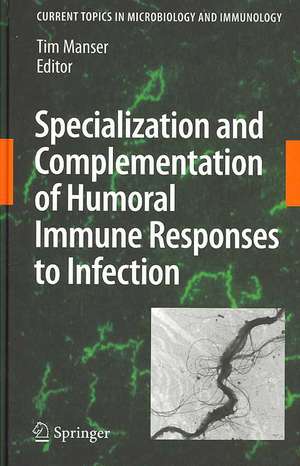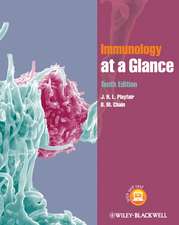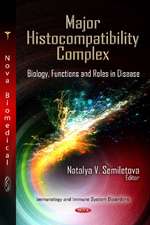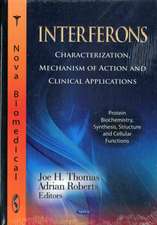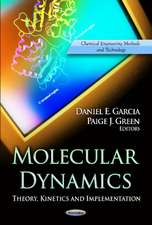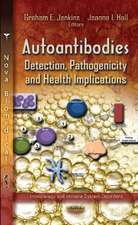Specialization and Complementation of Humoral Immune Responses to Infection: Current Topics in Microbiology and Immunology, cartea 319
Editat de Tim Manseren Limba Engleză Hardback – 22 noi 2007
| Toate formatele și edițiile | Preț | Express |
|---|---|---|
| Paperback (1) | 968.67 lei 38-44 zile | |
| Springer Berlin, Heidelberg – 30 noi 2010 | 968.67 lei 38-44 zile | |
| Hardback (1) | 1092.22 lei 6-8 săpt. | |
| Springer Berlin, Heidelberg – 22 noi 2007 | 1092.22 lei 6-8 săpt. |
Din seria Current Topics in Microbiology and Immunology
- 18%
 Preț: 962.03 lei
Preț: 962.03 lei - 5%
 Preț: 1123.13 lei
Preț: 1123.13 lei -
 Preț: 499.76 lei
Preț: 499.76 lei - 5%
 Preț: 967.79 lei
Preț: 967.79 lei - 18%
 Preț: 1118.62 lei
Preț: 1118.62 lei - 5%
 Preț: 717.00 lei
Preț: 717.00 lei - 5%
 Preț: 712.97 lei
Preț: 712.97 lei - 5%
 Preț: 709.51 lei
Preț: 709.51 lei - 5%
 Preț: 709.51 lei
Preț: 709.51 lei - 5%
 Preț: 721.19 lei
Preț: 721.19 lei - 5%
 Preț: 359.78 lei
Preț: 359.78 lei - 5%
 Preț: 711.88 lei
Preț: 711.88 lei - 5%
 Preț: 774.81 lei
Preț: 774.81 lei - 15%
 Preț: 640.06 lei
Preț: 640.06 lei - 5%
 Preț: 717.00 lei
Preț: 717.00 lei - 5%
 Preț: 360.34 lei
Preț: 360.34 lei - 5%
 Preț: 707.69 lei
Preț: 707.69 lei - 5%
 Preț: 717.56 lei
Preț: 717.56 lei - 5%
 Preț: 716.28 lei
Preț: 716.28 lei - 5%
 Preț: 717.20 lei
Preț: 717.20 lei - 5%
 Preț: 711.32 lei
Preț: 711.32 lei - 5%
 Preț: 711.88 lei
Preț: 711.88 lei - 5%
 Preț: 718.29 lei
Preț: 718.29 lei - 5%
 Preț: 709.51 lei
Preț: 709.51 lei - 5%
 Preț: 369.84 lei
Preț: 369.84 lei - 5%
 Preț: 712.25 lei
Preț: 712.25 lei - 5%
 Preț: 716.45 lei
Preț: 716.45 lei - 5%
 Preț: 706.60 lei
Preț: 706.60 lei - 5%
 Preț: 711.52 lei
Preț: 711.52 lei - 5%
 Preț: 713.54 lei
Preț: 713.54 lei - 5%
 Preț: 720.47 lei
Preț: 720.47 lei - 5%
 Preț: 725.42 lei
Preț: 725.42 lei - 5%
 Preț: 708.06 lei
Preț: 708.06 lei - 5%
 Preț: 713.70 lei
Preț: 713.70 lei - 5%
 Preț: 705.83 lei
Preț: 705.83 lei - 5%
 Preț: 710.96 lei
Preț: 710.96 lei - 5%
 Preț: 723.93 lei
Preț: 723.93 lei - 5%
 Preț: 707.69 lei
Preț: 707.69 lei - 5%
 Preț: 715.35 lei
Preț: 715.35 lei - 5%
 Preț: 709.87 lei
Preț: 709.87 lei - 5%
 Preț: 359.05 lei
Preț: 359.05 lei - 5%
 Preț: 374.20 lei
Preț: 374.20 lei - 15%
 Preț: 635.31 lei
Preț: 635.31 lei - 5%
 Preț: 707.86 lei
Preț: 707.86 lei - 5%
 Preț: 721.96 lei
Preț: 721.96 lei - 15%
 Preț: 632.88 lei
Preț: 632.88 lei - 15%
 Preț: 632.05 lei
Preț: 632.05 lei - 15%
 Preț: 642.83 lei
Preț: 642.83 lei - 5%
 Preț: 709.14 lei
Preț: 709.14 lei
Preț: 1092.22 lei
Preț vechi: 1149.71 lei
-5% Nou
Puncte Express: 1638
Preț estimativ în valută:
208.99€ • 218.21$ • 172.97£
208.99€ • 218.21$ • 172.97£
Carte tipărită la comandă
Livrare economică 05-19 aprilie
Preluare comenzi: 021 569.72.76
Specificații
ISBN-13: 9783540738992
ISBN-10: 3540738991
Pagini: 176
Ilustrații: XII, 162 p.
Dimensiuni: 155 x 235 x 15 mm
Greutate: 0.37 kg
Ediția:2008
Editura: Springer Berlin, Heidelberg
Colecția Springer
Seria Current Topics in Microbiology and Immunology
Locul publicării:Berlin, Heidelberg, Germany
ISBN-10: 3540738991
Pagini: 176
Ilustrații: XII, 162 p.
Dimensiuni: 155 x 235 x 15 mm
Greutate: 0.37 kg
Ediția:2008
Editura: Springer Berlin, Heidelberg
Colecția Springer
Seria Current Topics in Microbiology and Immunology
Locul publicării:Berlin, Heidelberg, Germany
Public țintă
ResearchCuprins
Pattern Recognition by B Cells: The Role of Antigen Repetitiveness Versus Toll-Like Receptors.- The Multifunctional Role of Antibodies in the Protective Response to Bacterial T Cell-Independent Antigens.- B Cell Lineage Contributions to Antiviral Host Responses.- The Important and Diverse Roles of Antibodies in the Host Response to Borrelia Infections.- A Distinct Role for B1b Lymphocytes in T Cell-Independent Immunity.- Secretory Immunity Following Mutans Streptococcal Infection or Immunization.
Textul de pe ultima copertă
In recent years the results of past studies on T cell dependent and T cell independent antibody responses have coalesced with discoveries regarding the roles of various primary B cell subsets and components of the innate immune system in conferring resistance to infectious pathogens. As a consequence, a new and more complete understanding of how antibody-mediated resistance to pathogens is elaborated has emerged. The recent explosion of knowledge of Toll-like receptor specificity and function has further embellished this understanding. It is now clear that there is not only extensive overlap and cross-complementarity in the action of innate and adaptive immune systems, but also specialization of function of the various B cell subsets and the types of antibodies they produce. This synergistic interaction of multiple components of these systems is perhaps best exemplified in antibody responses to bacteria. Contributions to this monograph were chosen to highlight this new perspective on antibody responses to infection, as well as to convey its practical implications, such as for contemporary vaccine design.
Caracteristici
Includes supplementary material: sn.pub/extras
